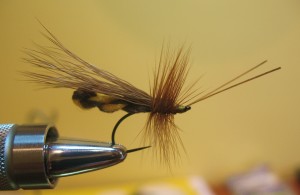
Furled Body StoneflyHook:
TMC 206BL size 8-10Body:
Poly yarn (color to match hatch)
Hackle: Color to match hatchWing:
Elk Hair, darker colored
Thread: Color to match hatch
Spring fishing for me means a lot of things. Towing big dragonfly nymphs, harassing horny bass, and searching for that elusive “chum fry hatch”, come to mind. I probably get most excited about spring time stoneflies though, little black stones, salmonflies, golden stones, and skwalas, to be exact. Golden stones and skwalas have a special place in my heart though. Why? Because I can find them about 5 minutes from my house, on my favorite river!
Right about this time of year big(ish) meaty skwalas will start hatching on the Deschutes and right after that golden stones will come off. Resident cutts and hungry sea-runs, thin from an arduous winter, attack these river dwelling creatures in both their nymph and adult form. When you hit it right, a fisherman can have a great day fishing big dries without the long trip over the pass.
What should you use? I suggest a furled body stonefly. It’s a pattern showed to me by a shop owner down in Clackamas Oregon. His pattern was mainly meant for salmonflies on the Oregon Deschutes, but is easily adapted to any stonefly you would like to imitate. This fly is not very hard to tie, but has some interesting techniques that are not commonly used. Here’s how you tie it.
First attach your thread and wrap the first 3rd of the shank, I use a short shanked hook because the body is what we call an extended body, which protrudes off of the fly. Tie in your poly yarn. This yarn can be whatever color you need to match the hatch with. It can be a single color, or you can combine colors for a more “realistic” look.
Next you need to take the poly and twist it. You will twist it until it doesn’t want to twist anymore.
Then you are going to take your bodkin and place it on top of the poly in the spot where you want your body to end. Then fold over your poly, hold it down to the shank with your forefinger and pull your bodkin out from the loop you just made.
The poly should twist upon itself (like a binimi twist knot). Tie the tag end down with your thread and trim away the excess. Now you are going to tie in your elk hair for the wing. The wing can be very sparse here. This fly has a poly body, elk wing, and hackle, keeping this fly afloat is no problem at all.
Trim off the butts on your wing, and tie in your hackle. Use 2 hackles about the same size. Strip off the fluffy stuff but keep the bare stems on the fly, we will use these. Tie in the hackles (bare stems first), wrap them up towards the head and tie them down. Now you can position the bare stems to look like antennae and trim them to an appropriate size. Whip finish the head and your fly is complete. Your fly should look something like this.

